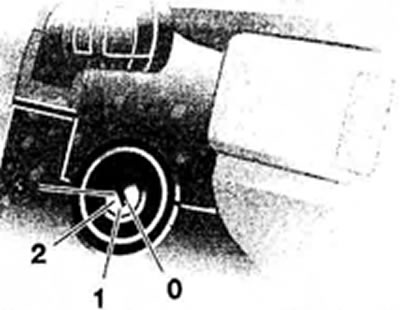Refueling
For the type and features of the use of fuel grades, refer to the materials Specifications of the current chapter.

The refueling hatch opens by pressing on its front edge.
Emergency unlocking of the fuel filler cap

1. Grasp the handle at the top of the right side panel of the trunk trim and pull it down.
2. Pull out the button with the dispenser symbol.
When handling fuel at filling stations, observe the safety regulations posted there.

The fuel tank cap should be inserted into the holder on the back of the fuel filler cap.
When refueling, place the filling nozzle on the fuel filler neck. If you raise the gun during refueling, this will lead to a fuel supply cutoff - to a weakening of the removal of gasoline vapors, if the gun has a system for removing these vapors.
Egnition lock
#img4#
0 - steering wheel is locked
The key can only be inserted into or removed from the lock in this position.
After removing the key, move the steering wheel slightly until it clicks into place.
1 - steering wheel unlocked
Turning the key from position 0 to position 1 is often facilitated by a slight wiggle of the steering wheel.
2 ignition on / for BMW 525tds: preheat
All current consumers are in working readiness.
3 starter activation
Engine start
Before launch
1. Apply the parking brake.
2. Set the transmission control lever to the neutral position, and in the presence of AT - to the P or N position.
3. At low outside temperatures, depress and hold the clutch pedal depressed.
Cars with a gasoline engine
Without depressing the accelerator pedal, start the engine.
You should not be limited to turning on the starter too briefly, but you should not keep it on for more than 20 seconds. Release the key as soon as the engine starts. Do not warm up the engine at idle, but immediately start driving at moderate speeds.
BMW 535i, 540i: Your BMW is equipped with a comfort start system. You just need to turn the ignition key to position 3 (starter activation) and immediately release it.
The starter works in automatic mode for some time and turns off automatically as soon as the engine starts.
If the battery voltage is insufficient, the automatic start of the engine is not performed and is not disabled. In this case, the engine can be started from the battery of another car (refer to the Introduction to the Guide).
If the engine (cold or overheated) does not start the first time, proceed as follows: To avoid splashing of the spark plugs, it is only possible to repeat the start attempt after a short pause. When starting the engine, keep the accelerator pedal depressed to about half way.
Starting a cold engine at low temperatures (below -15°С) and at high altitudes (over 1000 m above sea level).
At the first attempt to start the engine, keep the starter turned on a little longer than usual (about 10 seconds). Keep the accelerator pedal pressed down to about half of its travel.
If you have to start the engine frequently at low temperatures and at high altitudes, then change the engine oil to 5W-X viscosity oil (refer to chapter 1).
Diesel vehicles
With a cold engine:
- The ignition key must be in position 2 until the preheat indicator lamp or the corresponding message on the display goes out.
- Start the engine.
At extremely low outside temperatures, the starter can be kept on for no longer than 40 seconds.
With a warm engine: If the preheat indicator lamp does not light up, start the engine immediately Pressing the accelerator has no effect on the engine starting process.
Do not warm up the engine at idle, but immediately start driving at moderate speeds.
Removal of air from the diesel engine power supply system: if the fuel tank is empty, then. as a rule, removal of air from the power system is not required. If you still have problems starting the engine: Keep the starter engaged for about 20 seconds.
Never run the engine in enclosed spaces. Exhaust gases contain colorless and odorless, but highly toxic carbon monoxide. Inhalation of exhaust fumes is harmful to health and can cause loss of consciousness and death.
Since the car is a potential source of danger, never leave it with the engine running unattended.
Engine stop
To stop the engine, turn the key to position 1 or 0.
Never remove the key from the lock while the vehicle is moving. Otherwise, when turning the steering wheel, the steering column lock will be blocked. When leaving the vehicle, always remove the key from the ignition and lock the steering column lock.
Vehicles with manual transmission: When parking on steep roads, apply the parking brake, as engaging first gear or reverse gear under certain circumstances is not enough to prevent unintentional pulling away. Cars with AT: move the AT lever to position P.
